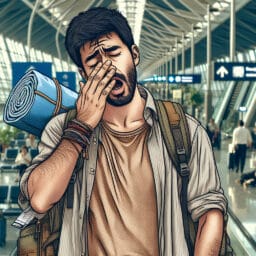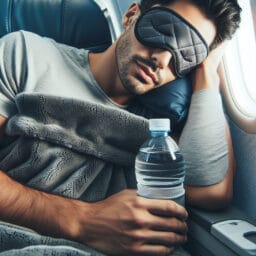
Sleep Optimization Tips for School-Age Children Who Travel Frequently
Table of Contents
- Introduction
- Understanding Sleep Needs for School-Age Children
- The Impact of Travel on Sleep
- Strategies for Sleep Optimization While Traveling
- Tips for Parents to Support Their Children’s Sleep
- Conclusion
- Frequently Asked Questions
Introduction
Hey there, travel-loving families! You know how grown-ups talk about jet lag and how tricky it can be to feel peppy after a long flight? Well, our little ones have the same thing going on with their tiny ticking body clocks. When we hop through time zones, kids’ circadian rhythms – that’s like an internal schedule for when to snooze or wake up – can get all out of whack. This means they might find it super tough to fall asleep when bedtime rolls around at your destination, or they might pop awake way too early!
So, let’s chat about some cool sleep solutions that help our kiddos adjust better when we’re traveling multiple time zones. First off, did you know light exposure is a big deal for telling our body clock what time it is? If you’re heading west where the day lasts longer, try to get your child some sunshine in the evening; it whispers to their brain, “Hey buddy, not quite bedtime yet!” And if you’re eastbound where the nights come earlier, morning rays are your friend.
Now let’s say you’ve reached this awesome new place – guess what can be a superhero for sleep health? Keeping a similar bedtime routine even while away from home. That’s right—storytime under a cozy blanket or brushing teeth together can signal sleepy-time even in a hotel room. Speaking of rooms, making the sleep space dark helps heaps. Cue those cute sleep masks or close those curtains tight!
Have you ever thought about scooting that bedtime just an hour earlier or later depending on which direction you’re zipping across the globe? It’s kind of neat because then your young adventurer gets to groove into the new schedule bit by bit without feeling all topsy-turvy.
And here’s something extra smart: Some families team up with newborn sleep coaches before big trips – these wizards teach us how to gently guide our kiddo’s sleep train onto new tracks. But remember (oops!), I mean keep in mind… every child has their own special rhythm; so whether yours is an early bird who loves dawn patrols or a night owl fascinated by stars – tailor those travel plans accordingly and watch them conquer any sleep challenge like champs!
Understanding Sleep Needs for School-Age Children
Did you know that school-age children should be snoozing for 9 to 11 hours each night? But here’s the kicker – not all kiddos are built the same. While one child might be bright-eyed and bushy-tailed after 9 hours, another might need a full 11-hour night sleep to charge their superpowers for the next day of adventures. And when we talk time zones, oh boy, does it get more complicated!
The amount of shut-eye our young travelers get isn’t just about avoiding crankiness or yawns; it’s a building block for their growing bodies and brains. Just like superheroes need their strength, kids’ muscles and bones do their most impressive growing while they’re off in dreamland. That’s right, growth hormone is on high gear during sleep! Not to mention, their little noggin locks in all those new things they learn–from spelling words to soccer kicks–while they’re catching those Zs.
But let’s face facts: Not getting enough rest can lead to a case of the grumps, sure, but it’s also tied to some real tough stuff like trouble with schoolwork and feeling all jumbled up inside. Without enough sleep, children might find it hard to keep their cool with friends or concentrate on what the teacher is saying. It’s like trying to play hopscotch on a wobbly pirate ship – everything’s harder when you’re sleepy!
Now let’s chat solutions because that’s what we’re here for! Sleep masks aren’t just for grown-ups – these nifty gadgets can help make any space a dark sleep space so your child can fall into dreamland no matter where you are. And sticking as close as possible to your usual bedtime routine even when you’re zip-zapping across time zones? That’s golden. It tells your kid’s internal clock that hey, no matter where we are in the world; it’s still bedtime.
Imagine this: You’ve conquered traveling multiple time zones; you’ve managed light exposure like a pro by using curtains or going outside at just the right circadian window; maybe even used some gentle sleep aids recommended by an expert pediatrician – and now your child wakes up fresh as a daisy ready to explore! With some know-how and planning, beating jet lag is totally within reach for young explorers!
So remember (wait, scratch that 😉), take note: Regular bedtimes + cozy routines = sweet dreams and happier travels. Whether it’s following through with storytime or ensuring not an inch of light peeks through during sleepy-time, helping your child adjust their sleep schedule smoothly means everyone enjoys the adventure from sunrise to sunset!
| Aspect | Details |
|---|---|
| Recommended Sleep | 9 to 11 hours per night |
| Individual Differences | Some children may need more or less sleep within the recommended range |
| Benefits of Sleep | Promotes growth, brain development, and memory consolidation |
| Consequences of Sleep Deprivation | Increased irritability, difficulty with schoolwork, and concentration challenges |
| Sleep Aids | Sleep masks, consistent bedtime routines, and managing light exposure |
| Travel Tips | Maintain bedtime routines and manage jet lag with strategic light exposure |
| Bedtime Routine Importance | Helps maintain a sense of normalcy and sets the internal clock for children |
| Goal for Parents | Ensure regular bedtimes and dark, quiet sleep environments for their children |
The Impact of Travel on Sleep
Traveling with young children is like carrying a delicate timepiece; it needs to be handled with care, especially when it comes to their sleep schedule. You see, every time we whisk our little ones across different time zones, their tiny internal clocks—those circadian rhythms that cue them when it’s time to wake or fall asleep—can get all tangled up. This tangle is what grown-ups call jet lag, and for young explorers, it means their body clock might say “playtime” when the new timezone insists “snooze-time.”
Here’s a brain-tickler: Did you know kids’ body clocks are more sensitive than ours? That’s right—so while we adults can chug coffee to beat jet lag, our kiddos need extra TLC to help their systems recalibrate. Imagine your child’s surprise when the sun shines bright at bedtime because you’re traveling west, or darkness falls way before they’re sleepy if headed east! Their entire night sleep rhythm is thrown off-kilter.
This is where some clever sleep solutions step in. It starts with manipulating light exposure—nature’s nudge for our circadian window—to reset those confused body clocks. A quick dash outdoors during strategic times can make a world of difference in aligning your child’s sleep cycle with local time.
But here comes the tricky part—maintaining a consistent sleep environment on-the-go. Back home, you’ve got the dark sleep space down pat; but what about in a hotel room awash with neon lights from outside? Enter portable black-out curtains and those adorable kiddie-sized sleep masks—they’re like superhero capes for your child’s eyes! And don’t forget some familiar bedtime routine elements—their favorite book or even that old lullaby can be powerful cues signaling “It’s beddy-byes time!” no matter where on the planet they lay their head.
Expert tip alert: Sleep training doesn’t have to pause while you travel. In fact, some families find maintaining elements of sleep training helps stabilize routines amidst change. While newborn sleep coaches might not always be within reach en route, their wise words resonate—a small hour earlier adjustment could ease transitioning between time changes without missing a dreamy beat.
Now imagine this: You’ve nailed avoiding jet lag like pros! With savvy planning and these tricks up your sleeve—an eye mask here, an adjusted bedtime there—you help your child adjust seamlessly as they conquer new horizons both awake and in dreams. After all, isn’t traveling about creating memories rather than lose precious moments wrestling with sleep problems?
So whether it’s ensuring not even a sliver of light disrupts their darkened room or infusing calmness into chaotic travel schedules; carving out a tranquil spot for rest becomes just another chapter in your family’s adventure storybook.
Strategies for Sleep Optimization While Traveling
Picture this: Your little trooper’s eyes are twinkling with excitement at the thought of exploring a new city or hiking through an enchanted forest. But hold up, folks! There’s something super crucial to consider for our mini-explorers – their precious sleep health. While the idea of jet lag might seem like grown-up stuff, young children have their own battles with time zones and internal clocks. Ensuring they get that golden slumber amidst thrilling travels is like finding treasure – it makes everything else shine!
Setting sail on adventures across the globe brings a wave of changes; from high-flying planes to cozy train compartments, each stop has its charm and challenge, especially when it comes to a child’s sleep train staying on track. Let’s dive into some savvy strategies that haven’t hit the map yet – how about syncing physical activity with local time to help your child adjust? That means if you land when it’s sunny, encourage some light playtime even if their body clock screams “nap!” This burst of energy can reset their sleep schedule quicker than you can say “Ahoy!”
As evening creeps in, we know screens are tempting travel buddies (hello long layovers!), but here’s a neat trick: cutting down on screen time before bed does wonders for preventing those bright lights from messing with your kiddo’s sleepy-time vibe. Instead, swap out tablets for books or quiet games that keep bedtime routines snug as a bug in a rug. And let’s talk grub – skipping heavy meals and caffeine close to night-night time means smoother sailing into dreamland.
Now imagine transforming any strange bunk or hotel room into your child’s darkened den – portable sleep aids such as white noise machines whisper tales of calm seas while drowning out unfamiliar sounds. And don’t overlook other bedtime heroes like cuddly blankets or treasured teddies from home; these familiar comforts are VIP guests at any sleepover.
If you’re crossing oceans and hopping through circadian windows, tune in to this pro-tip: adjust meal times alongside sleep times! Eating according to local hours helps signal your young one’s system – yep, even their tummy has a clock – that we’re following new rules now.
To top off your toolkit for combating sleep problems while roaming free across our planet, remember hydration is key! Keeping water handy ensures everything runs smoothly inside and out. See how simple switches like these can make all the difference? You might not have control over every twist and turn during travel but steering the ship towards consistent bedtimes and wake-ups whenever possible keeps everyone feeling shipshape.
With strategies up your sleeve such as gradual hour-earlier bedtimes depending on east or west-bound adventures, along with maintaining slices of home wherever you rest your heads – no bedtime beastie stands a chance against your knightly night-time routine!
So there we go adventurers! With creativity welded to science-backed know-how on child sleep needs during travel – we’ve crafted an armor so strong that no time change dragon can burn through it. Here’s raising our compasses high because conquering faraway lands by day (and snoozing soundly by night) makes for the happiest wandering warriors around!
Tips for Parents to Support Their Children’s Sleep
Ahoy, globe-trotting clans! Keeping young explorers chipper and bright-eyed during voyages requires a master plan—particularly when their sleep is at stake. Let’s draw the treasure map that guides us to serene slumbers even as we roam between castles and coastlines. Ever consider picking flights with an eye on the sandman? Timing your departure to match your tot’s nap or bedtime can be a game-changer, letting them snooze through the skies.
Teaching our mini-mates about the wonders of sleep isn’t just grown-up chatter—it’s crucial for their own sense of well-being. When kids grasp why zzz’s are their superpower, they’re more likely to embrace those cozy bedtime routines without a fuss. Plus, knowledge is power; understanding body clocks and circadian rhythms turns them into pint-sized sleep scientists ready to tackle any time change.
But wait, there’s more magic to unfurl! Unfamiliar beds in lands afar don’t have to spell restless nights. Picture this: after a day of adventures, you gather round for a calm-down huddle—deep breathing exercises or gentle yoga poses can whisk away excitement and tension alike. Whispered tales from home or soft melodies create a tranquil tide that carries your little sailor off into peaceful harbors of sleep.
And don’t forget the toolkit: portable sleep aids like sound machines whispering lullabies, snugly blankets smelling of home—their very own comfort crew! With these allies by their side, coupled with dim lighting and perhaps a spritz of lavender mist, these tiny travelers will be snoozing under starry skies or city lights faster than you can say “bon voyage.”
So there you have it—battling jet lag doesn’t require a miracle; it’s all about timing flights cleverly, weaving the science of sleep into storytime chats, and unlocking relaxation rituals. Transform any corner of the world into a dreamy den for your youngster, ensuring that every morning greets an adventure-ready child who understands their rest is treasured above all else on this grand journey called life.
Conclusion
Traveling can sometimes feel like a quest, with each new destination offering its own set of challenges—especially when it comes to maintaining your young adventurer’s sleep health. But who says quests can’t be fun? Here’s a nifty nugget: Kids are natural explorers, and adjusting their internal clock can be turned into an exciting mission! Begin by charting out the journey ahead; if you’re traveling west, encourage staying awake a little longer to greet the stars, but if heading east, get them nestled in bed as dusk falls to match the local circadian window. Introducing playful sleep masks or co-creating bedtime tales can make falling asleep in unknown lands part of the adventure. And remember, sneak in a dose of daylight at strategic times—it’s nature’s secret potion for syncing those tiny body clocks. By weaving these strategies into your travel tapestry, not only do you help your child beat jet lag and maintain a solid sleep schedule, but you also equip them with life skills that turn every time zone crossed into a conquered realm where dreams—and dreamers—flourish.




